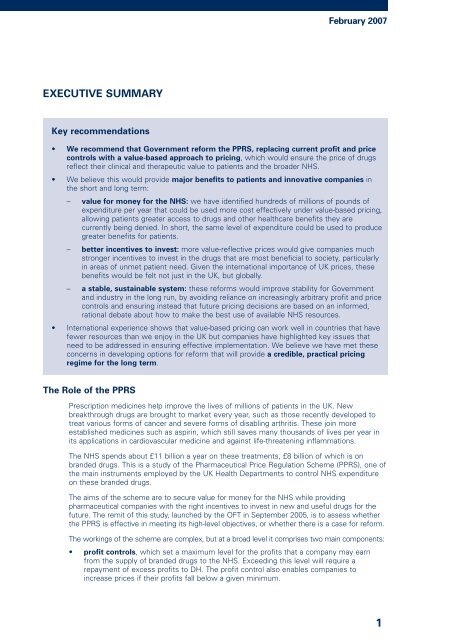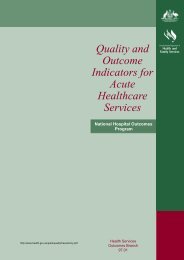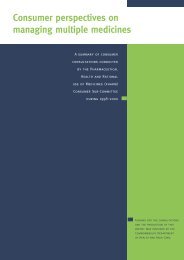The Pharmaceutical Price Regulation Scheme - Office of Fair Trading
The Pharmaceutical Price Regulation Scheme - Office of Fair Trading
The Pharmaceutical Price Regulation Scheme - Office of Fair Trading
You also want an ePaper? Increase the reach of your titles
YUMPU automatically turns print PDFs into web optimized ePapers that Google loves.
February 2007<br />
EXECUTIVE SUMMARY<br />
Key recommendations<br />
• We recommend that Government reform the PPRS, replacing current pr<strong>of</strong>it and price<br />
controls with a value-based approach to pricing, which would ensure the price <strong>of</strong> drugs<br />
reflect their clinical and therapeutic value to patients and the broader NHS.<br />
• We believe this would provide major benefits to patients and innovative companies in<br />
the short and long term:<br />
– value for money for the NHS: we have identified hundreds <strong>of</strong> millions <strong>of</strong> pounds <strong>of</strong><br />
expenditure per year that could be used more cost effectively under value-based pricing,<br />
allowing patients greater access to drugs and other healthcare benefits they are<br />
currently being denied. In short, the same level <strong>of</strong> expenditure could be used to produce<br />
greater benefits for patients.<br />
– better incentives to invest: more value-reflective prices would give companies much<br />
stronger incentives to invest in the drugs that are most beneficial to society, particularly<br />
in areas <strong>of</strong> unmet patient need. Given the international importance <strong>of</strong> UK prices, these<br />
benefits would be felt not just in the UK, but globally.<br />
– a stable, sustainable system: these reforms would improve stability for Government<br />
and industry in the long run, by avoiding reliance on increasingly arbitrary pr<strong>of</strong>it and price<br />
controls and ensuring instead that future pricing decisions are based on an informed,<br />
rational debate about how to make the best use <strong>of</strong> available NHS resources.<br />
• International experience shows that value-based pricing can work well in countries that have<br />
fewer resources than we enjoy in the UK but companies have highlighted key issues that<br />
need to be addressed in ensuring effective implementation. We believe we have met these<br />
concerns in developing options for reform that will provide a credible, practical pricing<br />
regime for the long term.<br />
<strong>The</strong> Role <strong>of</strong> the PPRS<br />
Prescription medicines help improve the lives <strong>of</strong> millions <strong>of</strong> patients in the UK. New<br />
breakthrough drugs are brought to market every year, such as those recently developed to<br />
treat various forms <strong>of</strong> cancer and severe forms <strong>of</strong> disabling arthritis. <strong>The</strong>se join more<br />
established medicines such as aspirin, which still saves many thousands <strong>of</strong> lives per year in<br />
its applications in cardiovascular medicine and against life-threatening inflammations.<br />
<strong>The</strong> NHS spends about £11 billion a year on these treatments, £8 billion <strong>of</strong> which is on<br />
branded drugs. This is a study <strong>of</strong> the <strong>Pharmaceutical</strong> <strong>Price</strong> <strong>Regulation</strong> <strong>Scheme</strong> (PPRS), one <strong>of</strong><br />
the main instruments employed by the UK Health Departments to control NHS expenditure<br />
on these branded drugs.<br />
<strong>The</strong> aims <strong>of</strong> the scheme are to secure value for money for the NHS while providing<br />
pharmaceutical companies with the right incentives to invest in new and useful drugs for the<br />
future. <strong>The</strong> remit <strong>of</strong> this study, launched by the OFT in September 2005, is to assess whether<br />
the PPRS is effective in meeting its high-level objectives, or whether there is a case for reform.<br />
<strong>The</strong> workings <strong>of</strong> the scheme are complex, but at a broad level it comprises two main components:<br />
• pr<strong>of</strong>it controls, which set a maximum level for the pr<strong>of</strong>its that a company may earn<br />
from the supply <strong>of</strong> branded drugs to the NHS. Exceeding this level will require a<br />
repayment <strong>of</strong> excess pr<strong>of</strong>its to DH. <strong>The</strong> pr<strong>of</strong>it control also enables companies to<br />
increase prices if their pr<strong>of</strong>its fall below a given minimum.<br />
1




